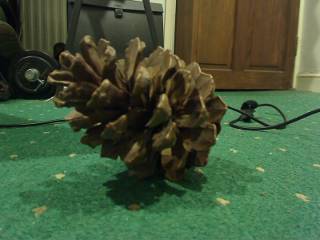
The I/O modules provide sources (and sinks) for video and audio data.
An image can be read from disk using read-image which uses the ImageMagick library to load the image.

(use-modules (aiscm core) (aiscm magick) (aiscm xorg))
(show (read-image "fubk.png"))Using colourspace conversions one can convert images to gray scale.
@..tests/integration/show_gray.scmwrite-image writes an image to disk.
(use-modules (aiscm core) (aiscm magick))
(write-image (arr (32 255 96 255) (255 160 255 224)) "pattern.png")
As shown above, you can display images under XOrg using the method show:
(use-modules (aiscm core) (aiscm magick) (aiscm xorg))
(show (read-image "fubk.png"))The size of the window is the size of the image by default. To override it, one can use the shape keyword argument.
(use-modules (aiscm magick) (aiscm xorg) (aiscm core))
(show (read-image "fubk.png") #:shape '(576 768))One can also display a list of images:

(use-modules (aiscm magick) (aiscm xorg) (aiscm core))
(define img (read-image "fubk.png"))
(show (list (* (rgb 1 0 0) img) (* (rgb 0 1 0) img) (* (rgb 0 0 1) img)))The fullscreen keyword can be used to open a borderless maximized window.
(use-modules (aiscm magick) (aiscm xorg) (aiscm core))
(show (read-image "fubk.png") #:fullscreen #t)It is also possible to display a video using the show method:
(use-modules (oop goops) (aiscm v4l2) (aiscm xorg) (aiscm core))
(define v (make <v4l2>))
(show (lambda _ (read-image v)))
(destroy v)One can use the shape keyword argument to customise the window size.
(use-modules (oop goops) (aiscm v4l2) (aiscm xorg) (aiscm core))
(define v (make <v4l2>))
(show (lambda _ (read-image v)) #:shape '(576 768))
(destroy v)A function returning lists of images can be used to display multiple videos synchronously.
The fullscreen keyword can be used to display a video in a borderless maximized window.
(use-modules (oop goops) (aiscm v4l2) (aiscm xorg) (aiscm core))
(define v (make <v4l2>))
(show (lambda _ (read-image v)) #:fullscreen #t)
(destroy v)(use-modules (oop goops) (aiscm v4l2) (aiscm core) (aiscm image) (aiscm xorg))
(define v (make <v4l2>))
(show (lambda _ (let [(img (from-image (read-image v)))] (list (red img) (green img) (blue img)))))
(destroy v)If necessary, one can also handle the display and window objects directly. Possible types of output are IO-XIMAGE, IO-OPENGL, and IO-XVIDEO. The following example shows showing, hiding, moving, resizing of windows. process-events needs to be invoked to process pending events.
(use-modules (oop goops) (aiscm v4l2) (aiscm xorg) (aiscm core))
(define v (make <v4l2>))
(define d (make <xdisplay> #:name ":0.0"))
(define w (make <xwindow> #:display d #:shape '(480 640) #:io IO-XVIDEO))
(title= w "Test")
(define (wait)
(while (not (quit? d)) (write-image (read-image v) w) (process-events d))
(quit= d #f))
(show w)
(wait)
(move w 20 40)
(wait)
(resize w 240 320)
(wait)
(move-resize w 30 60 360 480)
(wait)
(show-fullscreen w)
(wait)
(show w)
(wait)
(hide w)
(destroy d)
(destroy v)
As shown above already, you can open a camera and grab a frame as follows.
(use-modules (oop goops) (aiscm v4l2) (aiscm core))
(define v (make <v4l2>))
(read-image v)
; #<<image> YUY2 (640 480)>
(destroy v)It is also possible to specify the device, a channel, and a closure for selecting the video mode.
(use-modules (oop goops) (ice-9 rdelim) (aiscm v4l2) (aiscm core))
(define (select formats)
(for-each (lambda (i mode) (format #t "~a: ~a~%" i mode))
(iota (length formats))
formats)
(format #t "> ") (list-ref formats (string->number (read-line (current-input-port)))))
(define v (make <v4l2> #:device "/dev/video0" #:channel 0 #:select select))
(read-image v)
(destroy v)The following example program creates a sine wave and outputs it to the audio device.
(use-modules (oop goops) (aiscm pulse) (aiscm core))
(define sine (map (lambda (t) (inexact->exact (round (* (sin (/ (* t 1000 2 3.1415926) 44100)) 20000)))) (iota 441)))
(define samples (to-array <sint> sine))
(define output (make <pulse-play> #:typecode <sint> #:channels 1 #:rate 44100))
(channels output)
;1
(rate output)
;44100
(for-each (lambda _ (write-audio samples output)) (iota 300))
(drain output)The drain method waits for the content of the audio buffer to finish playing. The method flush (not shown here) can be used to empty the audio buffer.
Audio data can be recorded in a similar fashion. The following example records 3 seconds of audio data and then plays it back.
(use-modules (oop goops) (aiscm core) (aiscm pulse))
(define record (make <pulse-record> #:typecode <sint> #:channels 2 #:rate 44100))
(define play (make <pulse-play> #:typecode <sint> #:channels 2 #:rate 44100))
(for-each (lambda _ (write-audio (read-audio record 4410) play)) (iota 30))
(drain play)One can display a block-wise audio spectrum using the Tensorflow Fourier transform.
(use-modules (oop goops) (aiscm core) (aiscm pulse) (aiscm tensorflow) (aiscm xorg))
(define s (make-session))
(define w 400)
(define h 512)
(define sample (tf-placeholder #:dtype <float> #:shape (list 1 h)))
(define vec (tf-reshape sample (to-array <int> (list h))))
(define fourier (tf-rfft vec (to-array <int> (list h))))
(define spectrum (tf-mul (tf-log (tf-add (tf-real (tf-mul fourier (tf-conj fourier))) (tf-cast 1.0 #:DstT <float>))) (tf-cast 32.0 #:DstT <float>)))
(define record (make <pulse-record> #:typecode <float> #:channels 1 #:rate 11025))
(define ramp (* (indices h) (/ 2.0 h)))
(define window (to-type <float> (minor ramp (- 2.0 ramp))))
(define x 0)
(define img (fill <ubyte> (list (1+ (/ h 2)) w) 0))
(show
(lambda _
(let [(spec (run s (list (cons sample (* window (read-audio record h)))) spectrum))]
(set img x (list 0 (1+ (/ h 2))) (major (minor 255 spec) 0))
(set! x (modulo (1+ x) w))
img)))